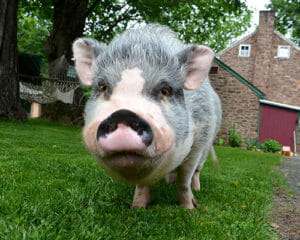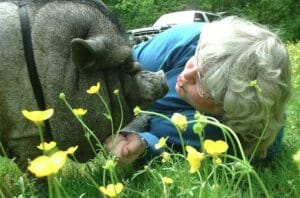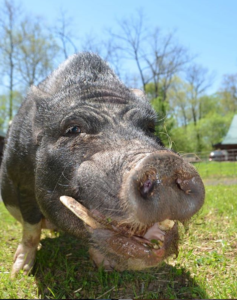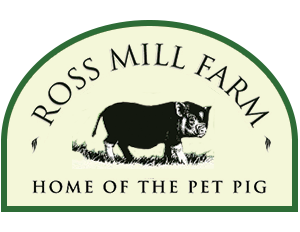Written by Kay Cranisky
Puppies, kittens, piglets… there’s no denying those baby animals are cute. When buying or adopting, people usually think “baby.” Nowhere is this truer than in the world of pet pigs where smallness is prized and piglets are considered the cutest. Unfortunately, all piglets do not end up as adult pigs with happy homes. As more and more clubs and rescue groups try to take responsibility for homeless and unwanted pigs, more owners are willing to try adopting an older pig.

Big Mac
Should you welcome an adult pig into your home or are you just taking on someone else’s problems? Will he or she bond to you, learn the rules, and respond to your training?
My pig was a year old when I adopted him. He had been a “barn pig” while I wanted a “house pig.” To complicate matters, I had no access to any pet pig reference material or other pig owners. Fortunately, I was not working and could devote the necessary time to him. After lots of work and mistakes, I am very happy with my “older” pig.
In order to help new and potential owners, we went to the experts for advice on adopting, training, and socializing an older pet pig. As John Vincent of “Hoggin” points out, there are some advantages to adopting an older pig.
Benefits of Adopting an Older Pig

Maximum
- If the size is a priority, an older pig may be good for you. A two-year-old pig will have a good bit of its adult size and a three-year-old pig is mostly full-grown.
- You will probably be able to see his “adult” personality.
- The pig will probably be housebroken, know tricks, walk on a leash, ride in the car, etc.
- He will not need to go out to the bathroom as frequently which can help with housebreaking.
- Older pet pigs are less expensive. Many piglets are sold or adopted for $300 – $800. The older a pig is, the less the cost to adopt, and many will have already been spayed or neutered.
If you are considering adopting a pig, be sure you have the time to devote to a companion animal. Vincent says people should know that pigs can be more work than dogs. Linda Good compared adopting a pet pig to adopting a child.
“The pig will test you.”
If you are looking for a low-maintenance pet, it might be better to dust off your pet rock and wait until your lifestyle permits more time.
Do Your Homework

Susan Magidson, co-founder of the Pig Placement Network and owner of Ross Mill Farm points out that it is especially important to learn as much as you can about the pig’s background. The placement must be a good match for both the people and the pig. For example, if the pig was thriving in an indoor setting with children, a similar setting would be a desirable second home. However, if the pig was indoors and alone all day and became destructive, an outdoor setting or one in which the owners are home our be preferable.
Bringing an outdoor pig indoors can be challenging. This requires teaching housebreaking skills and other manners that may not have been necessary in the previous home. Magidson recommends having an outdoor area ready for all pigs before bringing them home. Remember, pigs prefer a low ceiling (crate, under a table) where they can feel protected. Sharon Smart of Southern California Association Miniature Potbellied Pigs, tells us that they have successfully brought several “outdoor” piggies indoors. The pig must be given the chance to re-learns skills in the new home.
Bringing an Older Pig Home
John Vincent’s pig Hoover was adopted at about two-and-half-years of age. While Hoover is not as affectionate and approachable as the other pigs, he has responded well to training and lives in the house. Vincent gave the following tips:
- It takes patience to educate your pig. He must learn what is expected. No hurting or scaring the pig! Establish house rules in an atmosphere of mutual respect. Move slowly.
- The pig will be more comfortable in a particular place in the house, which is near his food. Work on approaching the pig slowly, but not to the point where he actually runs away.
- Training is critical. Adapt basic techniques to the pig’s personality. Learn your pig’s patterns. Follow the same housebreaking steps you would for a young pig.
- Set up situations where your pig will not fail. Give him the same opportunity to learn that you would give a piglet.
- Make him earn his food. In the beginning, this may mean letting the handler stand across the room while the pig eats.
- Formerly aggressive pigs will not be aggressive at first in the new setting but may become more aggressive if not trained. Stand up to the pig and set the rules from the beginning.
Vincent suggests that fist time owners approach the pig as they would a large, frightened dog.

Building Trust
Magidson stresses the need for allowing the pig to come to you. Get on the floor or ground as eye level. Patience is key. Pigs have long memories and will remember their separation from the first home. It will take time to earn their trust. Pigs also thrive on a consistent schedule and routine.
Magidson recommends using petting, belly scratches, etc to win the pig’s affection. If only food is used the pig may view you as simply a vending machine rather than a companion. You may want to use food initially to begin touching the pig. You can sit with the pig while it eats and begin petting it. Some pigs may not allow you to do this. If that’s the case, you can hand-feed the pig treats so you can begin to earn their trust. You can also put treats on your lap and allow the pig to come to you. All these techniques will help to build the pig’s trust in you and help him to become accustomed to your touch.
Magidson’s Other Tips:
- Try to find an experienced owner or join a pig owners group who will offer you advice and support.
- Get a vet check after the pig adapts to its new home, sooner only if an immediate problem arises.
- Transport your pig home in a crate.
- Use a safety harness to keep your pet pig from bolting.
- A dose of Heartland’s Exotics Survival Plus before leaving the old home and for a few days in the new home can help to counteract some symptoms of stress. Rescue Remedy, available at most vitamin stores, will provide similar stress relief.
- Blown coat syndrome may occur in some pigs in stressful situations. The pig may lose its hair, but no treatment is needed. Groom the pig while he is calm. His hair will grow back.
- Housebreaking should be done one room at a time.
Can adopting an older pig work out? YES, but as with the introduction of any new animal to your home, it takes time, patience, training, and understanding. You will be saving an unwanted pig and giving him a second chance at life. Your efforts will pay off with many years of loving companionship!

Happy to see you!


